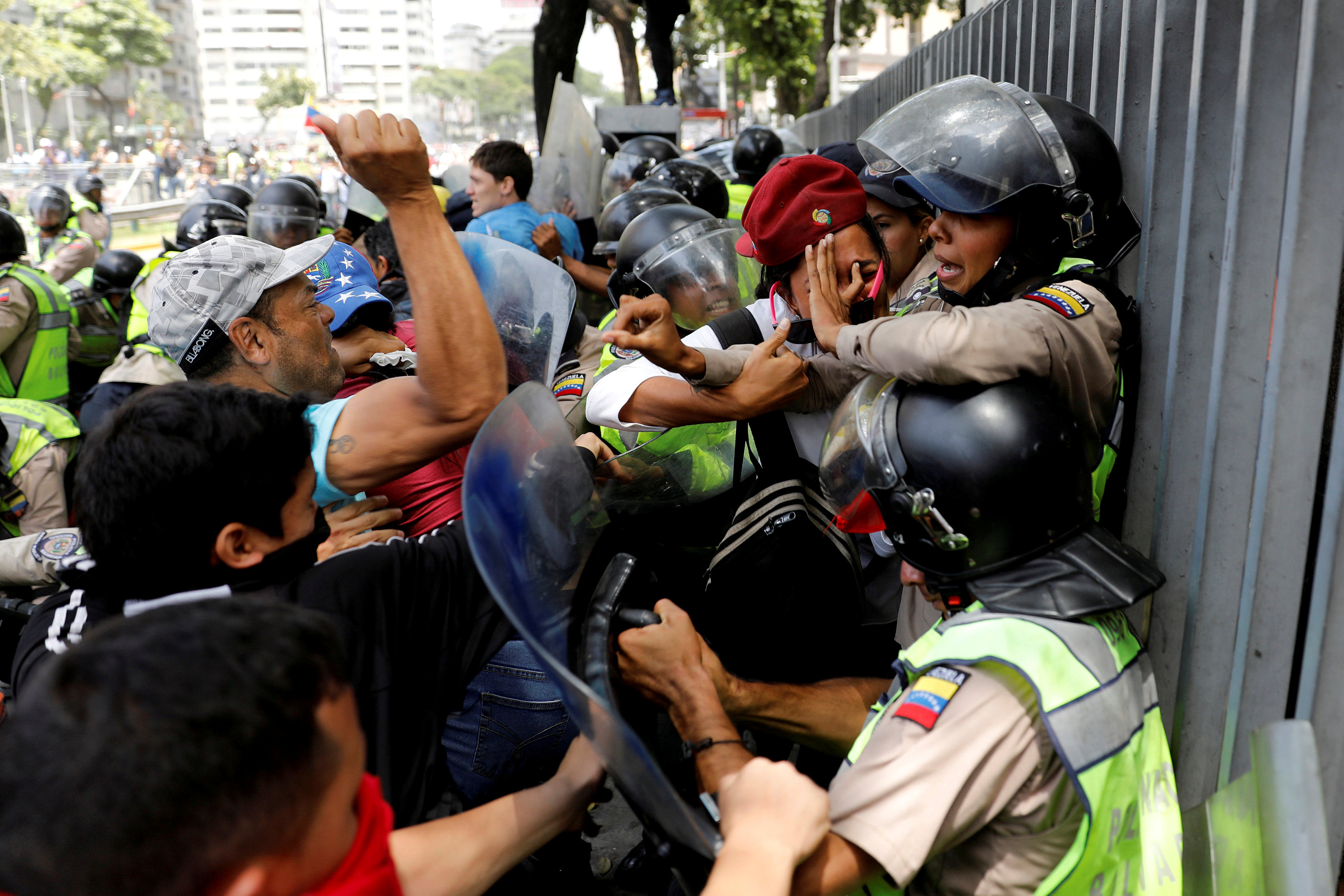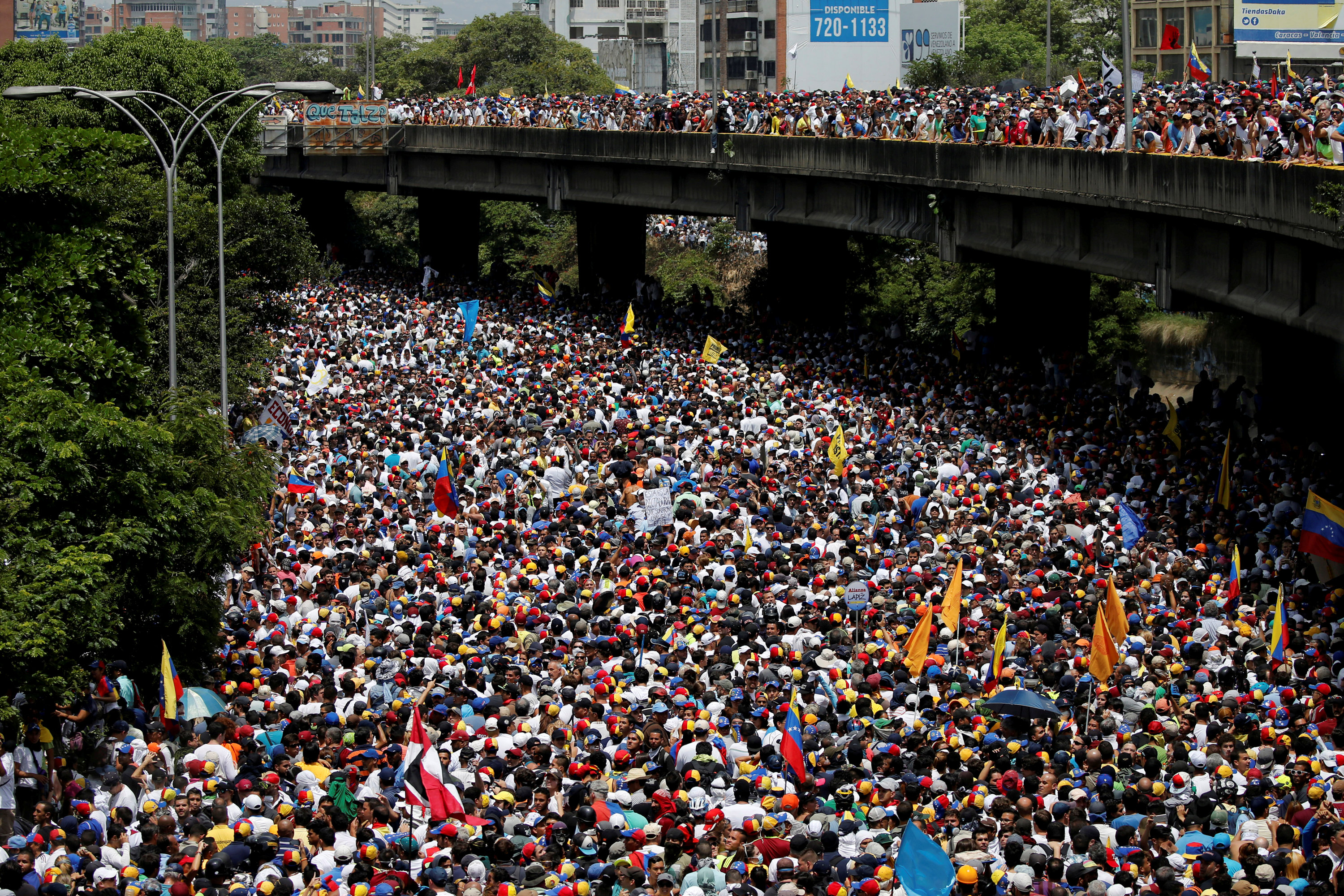By Andrew Cawthorne
CARACAS (Reuters) – Even by the volatile and violent standards of recent times in Venezuela, 2017 was an exceptional year, a “perfect storm” of political and economic crisis.
Going into a fourth year of crippling recession, Venezuela’s 30 million people found themselves skipping meals, suffering shortages of basic foods and medicines, jostling in lines for ever-scarcer subsidized goods, unable to keep up with dizzying inflation rates, and emigrating in ever larger numbers.
In unprecedented scenes for the once-prosperous OPEC nation, some citizens survived only by scavenging through garbage.

Demonstrators scuffle with security forces during an opposition rally in Caracas, Venezuela, April 4, 2017. Venezuelan security forces quelled masked protesters with tear gas, water cannons and pepper spray in Caracas after blocking an opposition rally against socialist President Nicolas Maduro. The clashes began after authorities closed subway stations, set up checkpoints and cordoned off a square where opponents had planned their latest protest against the government and the crippling economic crisis. Carlos Garcia Rawlins: “For me that was the day that made a difference, never before had I seen the protesters and police clashing men-to-men and struggling back and forward. From then, the strategy of the police changed and they never faced the protesters so close again.” REUTERS/Carlos Garcia Rawlins/File Photo
Not surprisingly in that context, President Nicolas Maduro’s ruling Socialists – the inheritors of Hugo Chavez’s “21st century revolution” – – lost popularity on the street, and the opposition coalition sensed a chance to unseat them.
The tipping point came in March when the pro-Maduro Supreme Court essentially took over functions of the opposition-led National Assembly. Though the controversial ruling was later modified, it was a trigger and rallying cry for the opposition, which began a campaign of street protests that ran from April to July.
Hundreds of thousands took to the streets across Venezuela, decrying economic hardship, demanding a presidential election, urging a foreign humanitarian aid corridor, and seeking freedom for scores of jailed activists.
Slogans that read “Maduro, murderer!” and “Maduro, dictator!” began appearing on roads and walls around the country. Though the majority of protesters were peaceful, youths wearing masks and brandishing homemade Viking-style shields started turning up at the front of rallies to taunt security forces.
When police and National Guard soldiers blocked marches, youths threw Molotov cocktails and stones. The security forces quickly escalated tactics, routinely turning water-cannons on the protesters and firing teargas into crowds.
Guns appeared on the streets, and on several occasions security officials were caught on camera firing directly at demonstrators. Police were targeted with homemade explosives. Opposition supporters burned one man alive.
The deaths, injuries and arrests mounted. Over the chaotic months, at least 125 people died, thousands were injured and thousands were jailed.

Demonstrators march during the so-called “mother of all marches” against Venezuela’s President Nicolas Maduro in Caracas, Venezuela, April 19, 2017. Carlos Garcia Rawlins: “That day was one of the biggest rallies up to then. There were thousands of people trying to find their way to the office of the state ombudsman after gathering in more than two dozen points around Caracas. But as in previous rallies, they were blocked by the National Guard. Waving the country’s yellow, blue and red flag and shouting ‘No more dictatorship’ and ‘Maduro out,’ demonstrators clogged a stretch of the main highway in Caracas. I remember the desperation of the people trying to escape the tear gas and not having space to run because there were so many.” REUTERS/Carlos Garcia Rawlins/File Photo
Global opinion hardened against Maduro. Amid the extraordinary daily events, gangs burst into the National Assembly and beat up opposition lawmakers. The nation’s best-known jailed opposition leader, Leopoldo Lopez, was released from prison and placed on home arrest to the joy of his supporters, then taken back to jail, then allowed home again, all in a matter of days.
Venezuelans grew accustomed to navigating around barricades and burning streets as they tried to get to school and work. Some days, the country virtually shut down.
By the end of July, many opposition supporters feared for their lives and protest numbers dwindled. Maduro said he was defeating a U.S.-backed coup attempt and authorities held an election, which the opposition boycotted, for an all-powerful Constituent Assembly charged with imposing order on the country.
Having failed to block the Constituent Assembly, the protests fizzled out, leaving opposition supporters nursing their wounds and planning their next moves.
They decided to tackle Maduro at the ballot-box in regional elections in October, but that backfired badly when they lost most of the governorships despite polls showing they would win. The opposition alleged fraud, but their complaints did not get traction and Maduro cemented his authority.
In November, Venezuela said it planned to renegotiate its entire foreign debt, adding another dimension to the deepening national crisis.
(See http://reut.rs/2AdRQ0Q for related photo essay)
(Reporting by Andrew Cawthorne; Editing by Toni Reinhold)
 A protestor holds a national flag while standing in front of a fire burning at the entrance of a building housing the magistracy of the Supreme Court of Justice and a bank branch, during a rally against Venezuela's President Nicolas Maduro, in Caracas, Venezuela, June 12, 2017. Protesters angry at the pro-government Supreme Court's ruling attacked a branch of the court with petrol bombs. Carlos Garcia Rawlins: "As had happened before, security forces from inside the building repelled the attack, but this time the clashes were more intense. The demonstrators looted and burned a bank branch in the same building, which was later engulfed in smoke and flames. By the end of the day, several protesters were injured and detained." REUTERS/Carlos Garcia Rawlins/File Photo
A protestor holds a national flag while standing in front of a fire burning at the entrance of a building housing the magistracy of the Supreme Court of Justice and a bank branch, during a rally against Venezuela's President Nicolas Maduro, in Caracas, Venezuela, June 12, 2017. Protesters angry at the pro-government Supreme Court's ruling attacked a branch of the court with petrol bombs. Carlos Garcia Rawlins: "As had happened before, security forces from inside the building repelled the attack, but this time the clashes were more intense. The demonstrators looted and burned a bank branch in the same building, which was later engulfed in smoke and flames. By the end of the day, several protesters were injured and detained." REUTERS/Carlos Garcia Rawlins/File Photo
